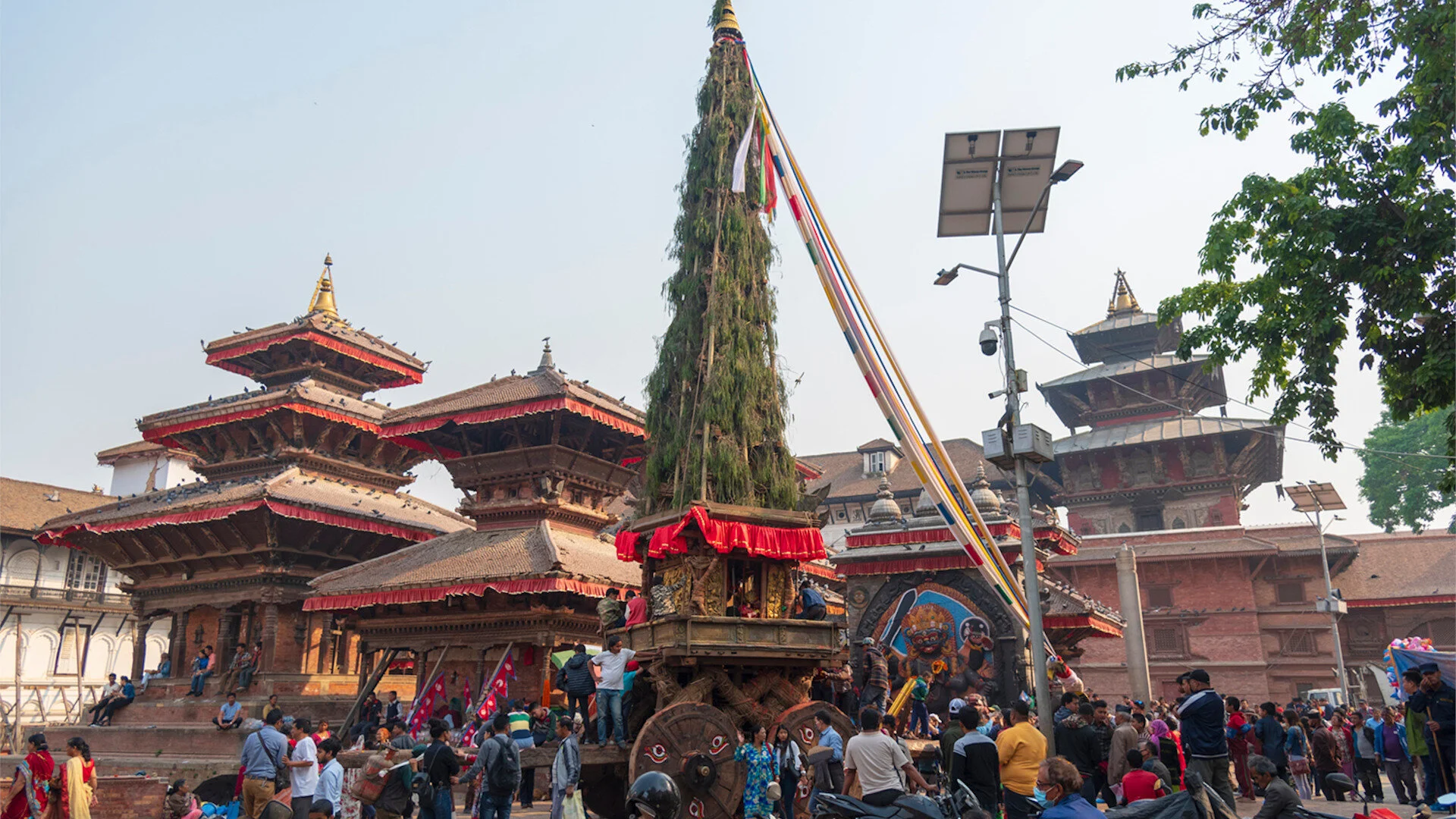Jana Baha Dyo Jatra
Celebrated In: March*
Commonly known as Seto Matsyendrath, it is natively known as Jana Baha Dyo, Yalameshwor. The chariot procession is marked for Chaitya Dashain, and the building process is commenced a week prior. A group of traditional builders with the help of volunteers build the 4 storied chariots shaped in Shikhara architecture.
The chariot makes its way through various parts of the old routes of Kathmandu. The chariot is pulled within 3 days and on the third day a special puja is conducted after which the image of Jana Baha Dyo is taken back to the temple at Jana Bahal.
The chariot makes it’s way from Durbar Marg to Bhotahity and rests in Asan on the first day. After which it is pulled to Ket Tol, Indra Chowk, and rests in Hanuman Dhoka. On the final day, it makes its way through Basantapur Durbar Square, Jasidega and circles the mother tree three times in Lagan.
Learn More About Jana Baha Dyo Jatra: The Chariot Festival of Seto Matsyendranath
Biskah Jatra
Celebrated In: April*
Biskah Jatra which is commonly known as Bisket Jatra is a festival which is celebrated according to the solar calendar (Bikram Sambat) rather than the lunar Nepal Era Calendar. It is derived from the word, “Bee Sikah”, which means ‘after the death of the serpents’. The festival is centred around the worship of the deities Lord Bhairav and Goddess Bhadrakali. The festival lasts for a total of 9 days from the 27th of Chaitra to 5th of Baisakh.
A procession of two chariots, being pulled in a tug-of-war setting between Thane(Upper) and Kone(Lower) part of town begins the festivities of Biskah Jatra. Two lingo’s known as Yo Shi (55-feet-tall each) are erected in two different locations of the central city on New Year’s Eve and brought crashing down on New Year’s Day symbolizing the killing of the serpents. To symbolize the consummation of the marriage, the two raths (chariots) are made to crash against each other. This occurs during midnight when the Bhairab and Bhadrakali chariots are collided symbolizing copulation.
Learn More About Biskah Jatra Here: Tales Of Biskah Jatra
Bunga Dyo Jatra
Celebrated In: April-May*
Dubbed as one of the longest chariot festivals of the world, the Bunga Dyo Jatra holds huge importance in the Newar Pantheon. Also known as Rato Matsyendranath, the festivals origin dates back to the Lichhavi era.
The chariot festival commences a day after Mata Tirtha Ausi ( National Mothers Day) when the idol of Karunamaya is placed onto the chariot which is built at Pulchowk of Lalitpur. The elements of the chariot hold multiple significance in regards to the journey of bringing Karunamaya into the valley. The chariot is pulled by revellers on the fourth day after it is placed in the chariot. It makes its way through the ancient routes of Patan and ends in Jawalakhel after which the Bhoto (Vest) is displayed. After which the idol of Karunamaya is taken home to Amarpur (Bungamati) where it spends the next six months, after which a few weeks before Yomari Punhi the idol is brought to Patan and placed at Ta Bahal of Lalitpur.
Locally known as Bunga Dyo, the deity is also known as Karunamaya Lokeshwor who is regarded as the deity of compassion according to Buddhism. In local significance, the deity is the patron deity of Bungamati thus the name Bunga Dyo. The farmers of the Nepal Mandala ( The Valley Kingdom of Nepal) worship the Bunga Dyo as the god of rain.
Learn More About The Chariot Festival Here: The Festival of Rato Matsyendranath
Learn More About The Bhoto Here: The Legend Of Bhoto Jatra
Swanya Punhi
Celebrated In: May-June*
The day of Buddha Jayanti is known as Swanya Punhi in Nepal Bhasa. This day is celebrated as the day of birth, enlightenment and death of Lord Buddha, who is regarded as the light of Asia. Devotees and worshippers take special pilgrimages to various Buddhist sites, monuments, monasteries in and around the valley.
Sithi Nakhah
Celebrated In: June*
The festival of Sithi Nakhah is the last in the festive calendar of the Newar people. It is a festival that is dedicated to Lord Kumar, which falls on the sixth day of the bright lunar fortnight. Kartikeya Kumar is traditionally known as Sithi Dyah in Nepal Bhasa. It is believed that he was born on this day. Devotees take a holy bath and also clean their households on this day. Various public areas such as well's, conduits, pathi’s and pauwa’s are cleansed on this day. Households prepare Chatamari- a typical Newari delicacy made from rice flour crepe along with which Wo- which is a flat cake of black lentils.
*: As Newar festivals are celebrated according to the lunar Nepal Era calendar, the dates in the Gregorian calendar are interchangeable.















